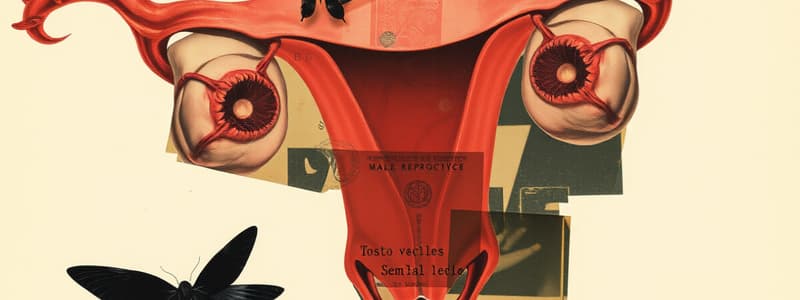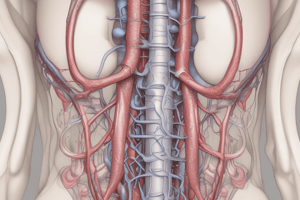Podcast
Questions and Answers
What is the primary function of the urethra in males?
What is the primary function of the urethra in males?
- Conduct urine and semen (correct)
- Transport sperm only
- Store sperm
- Produce testosterone
Which gland is responsible for secreting most of the fluid in semen?
Which gland is responsible for secreting most of the fluid in semen?
- Prostate Gland
- Cowper Gland
- Seminal Vesicles (correct)
- Leydig Cells
What is the role of Leydig Cells in the male reproductive system?
What is the role of Leydig Cells in the male reproductive system?
- Produce testosterone (correct)
- Store sperm cells
- Secrete seminal fluid
- Conduct sperm to penis
Which gland helps neutralize the acidity of the urethra?
Which gland helps neutralize the acidity of the urethra?
What substance is mainly emitted from the male reproductive tract?
What substance is mainly emitted from the male reproductive tract?
The prostate gland is located:
The prostate gland is located:
What is one of the functions of testosterone in males?
What is one of the functions of testosterone in males?
What does the scrotum primarily do?
What does the scrotum primarily do?
What is the main function of Sertoli cells in the male reproductive system?
What is the main function of Sertoli cells in the male reproductive system?
Which hormone is primarily responsible for maturing the egg in females?
Which hormone is primarily responsible for maturing the egg in females?
What is the role of the fimbriae in the female reproductive system?
What is the role of the fimbriae in the female reproductive system?
What structure in sperm contains the enzymes needed to penetrate an egg?
What structure in sperm contains the enzymes needed to penetrate an egg?
Which of the following correctly describes the myometrium?
Which of the following correctly describes the myometrium?
The primary role of progesterone in the female reproductive system is to:
The primary role of progesterone in the female reproductive system is to:
What is the function of the cervix in the female reproductive system?
What is the function of the cervix in the female reproductive system?
How long does it take for sperm to mature in the male reproductive system?
How long does it take for sperm to mature in the male reproductive system?
What is the primary hormone that surges during ovulation?
What is the primary hormone that surges during ovulation?
What occurs to the primary oocyte during the ovarian cycle?
What occurs to the primary oocyte during the ovarian cycle?
What is the function of human chorionic gonadotropin (hCG) during pregnancy?
What is the function of human chorionic gonadotropin (hCG) during pregnancy?
How long does the luteal phase typically last?
How long does the luteal phase typically last?
What happens to the corpus luteum if fertilization does not occur?
What happens to the corpus luteum if fertilization does not occur?
During which phase of the menstrual cycle does ovulation occur?
During which phase of the menstrual cycle does ovulation occur?
Which symptom is NOT typically associated with premenstrual syndrome (PMS)?
Which symptom is NOT typically associated with premenstrual syndrome (PMS)?
What happens to the secondary oocyte if fertilization occurs?
What happens to the secondary oocyte if fertilization occurs?
During which phase of the cell cycle does DNA synthesis occur?
During which phase of the cell cycle does DNA synthesis occur?
What is the key function of cytokinesis?
What is the key function of cytokinesis?
In which phase do chromosomes line up in the center of the cell?
In which phase do chromosomes line up in the center of the cell?
Which phase is NOT part of mitosis?
Which phase is NOT part of mitosis?
What happens to chromosomes during Anaphase?
What happens to chromosomes during Anaphase?
Which phase of interphase is primarily associated with cell growth and synthesis of organelles?
Which phase of interphase is primarily associated with cell growth and synthesis of organelles?
What is the main outcome of meiosis?
What is the main outcome of meiosis?
What occurs during Telophase?
What occurs during Telophase?
What happens to homologous chromosomes during Anaphase I?
What happens to homologous chromosomes during Anaphase I?
What characterizes Meiosis II compared to Meiosis I?
What characterizes Meiosis II compared to Meiosis I?
What occurs during Telophase II?
What occurs during Telophase II?
Which phase of meiosis is similar to mitosis regarding the behavior of sister chromatids?
Which phase of meiosis is similar to mitosis regarding the behavior of sister chromatids?
What is produced at the end of Telophase I?
What is produced at the end of Telophase I?
What role does genetic recombination play in a population?
What role does genetic recombination play in a population?
Which of the following correctly describes the rhythm calendar method?
Which of the following correctly describes the rhythm calendar method?
What is a key characteristic of Meiosis I?
What is a key characteristic of Meiosis I?
Flashcards are hidden until you start studying
Study Notes
Male Reproductive System
- The urethra serves a dual purpose, allowing the passage of both semen and urine.
- Semen, containing sperm cells from the male reproductive tract, plays a crucial role in fertilization.
- The penis functions as the organ for sexual intercourse, facilitating reproduction and urination by depositing semen into the vagina.
Ejaculatory Duct
- Conducts sperm from the seminal vesicle into the prostate gland, facilitating transport to the penis.
Accessory Glands
- Scrotum: A pouch of skin that houses the testicles and maintains a cooler temperature for sperm production.
- Seminal Vesicles: Two glands that secrete a nourishing thick fluid, contributing the majority of semen's liquid.
- Prostate Glands: A walnut-sized gland that surrounds the urethra, adding fluid to sperm to form semen.
- Cowper Gland (Bulbourethral Gland): Small glands that secrete a sticky fluid to neutralize the urethra's acidity.
Male Hormones and Testosterone Function
- Leydig cells produce testosterone, stimulated by Luteinizing Hormones (LH).
- Testosterone regulates growth and function of the male reproductive tract, stimulates sexual behavior, and promotes secondary sexual traits like facial hair and a deeper voice.
Structure of Sperm
- Mature sperm take approximately 9-10 weeks to develop.
- Components include:
- Tail (flagellum): For movement.
- Midpiece: Contains mitochondria for energy.
- Head: Contains a nucleus with DNA and an acrosome to penetrate the egg.
Female Reproductive System
- Ovary: Produces and stores eggs (oocytes) and sex hormones (estrogen and progesterone), contributing to secondary sexual traits and egg maturation.
- Fallopian Tubes/Oviduct: Carry eggs from the ovaries to the uterus, serving as a site for fertilization.
Accessory Glands in Females
- Fimbriae: Finger-like structures that catch eggs and direct them to the oviduct.
- Uterus: The cavity where a fertilized egg implants; consists of the myometrium (muscle layer) and endometrium (lining).
- Cervix: The lower uterus part, serving as an opening into the vagina and secreting mucus to enhance sperm movement.
Ovulation and Menstrual Cycle
- Ovulation occurs roughly 14 days into the cycle and lasts for 24 hours. LH surges are critical for this process.
- Symptoms include a slight increase in basal body temperature.
- Primary oocytes mature monthly, completing meiosis I before ovulation and forming secondary oocytes thereafter.
Luteal Phase
- Following ovulation, the corpus luteum forms, releasing progesterone and estrogen to maintain uterine lining for potential implantation.
- Symptoms of premenstrual syndrome (PMS) include bloating, mood changes, headaches, weight gain, and food cravings.
Phases of Cell Division
- Mitosis: Involves prophase, metaphase, anaphase, telophase, and cytokinesis, leading to two identical daughter cells.
- Meiosis: Consists of two divisions, producing gametes with genetic variation. Meiosis I reduces chromosome number, while Meiosis II resembles mitosis without interphase.
Birth Control
- Contraception prevents pregnancy through medicinal, device, or surgical means, critical for managing family size and human population growth.
- Natural methods include the rhythm calendar, which involves tracking ovulation periods to avoid intercourse during fertile days.
Studying That Suits You
Use AI to generate personalized quizzes and flashcards to suit your learning preferences.



